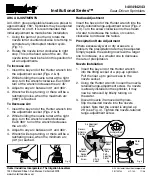
C-Nav Hardware Reference Guide
22
Figure 2-4: C-Nav3050 Antenna TNC Connector
2. Slacken the coaxial cable and attach to the antenna mounting pole with a zip-tie. This
will prevent any undue strain on the cable connector and antenna.
3. With the cable connected to the antenna, run the cable down the mast, securing with zip
ties every 3 or 4 feet.
Figure 2-5: C-Nav3050 Antenna and Coaxial Cable
4. Carefully lay the cable along the chosen route to further detect any potential kinks,
bends or spots where the cable may become damaged.
5. Secure the cable along the cable route with tape or zip ties and place a label at the
GNSS receiver end of the cable for identification purposes.
6. Connect the coaxial cable to the TNC connector on the GNSS receiver. Ensure that any
slack in the cable is neatly stowed and that the minimum bend radius is not exceed
during this process.
Zip-ties securing
coaxial cable in
place (cable runs
along opposite
side of mast)
Notice the slack in
the cable, done to
prevent undue
stress on the
connections
Excess Coaxial
Cable neatly
stowed
Summary of Contents for IALA
Page 1: ...DGNSS Systems Hardware Guide www cnavgnss com...
Page 20: ...C Nav Hardware Reference Guide 20 Figure 2 3 C Nav Antenna Mounting Pole Dimensions...
Page 65: ...C Nav Hardware Reference Guide 65 Model No 3402 17 0070 Specifications...
Page 67: ...C Nav Hardware Reference Guide 67 Huber Suhner Lightning Protector Mounting Instructions...
Page 68: ...C Nav Hardware Reference Guide 68...
Page 69: ...C Nav Hardware Reference Guide 69 MOXA Converters TCC 80I TCC 80I Specifications...
Page 72: ...C Nav Hardware Reference Guide 72 Times Microwave LMR400 Coaxial Cable LMR400 Specifications...
















































